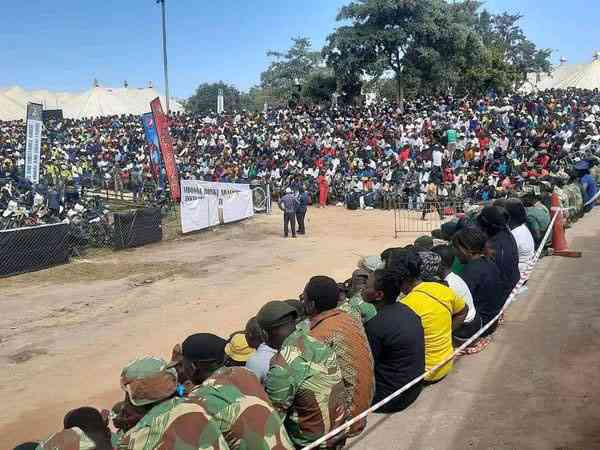
I WOULD like to thank all the artists and stakeholders especially the media for supporting, as well as criticising the National Arts Merit Awards (NAMA) that has helped build the brand over the past 17 years. I am fortunate to have been there when NAMA started and am still there and would like to express my views and hopefully explain one or two things that some people may have overlooked in their criticism or praise of NAMA. By Elvas Mari
It is important to appreciate that NAMA are established by National Arts Council of Zimbabwe (NACZ), created through an Act of Parliament in 1985. Any product of any organisation or individual has to achieve the values and mandate of the organisation that created it. Therefore, for people to appreciate the NAMA they have also to appreciate the mandate and values of NACZ.
The mandate of NACZ is to develop and promote the arts in Zimbabwe. This is done through programmes and activities, as well and creating a funding and operating environment for the development and promotion of the arts. One of the strategies to develop and promote the arts in Zimbabwe is through giving artists and practitioners their recognition. The awards are meant to stimulate more interest in the arts and attract requisite sponsorship for the arts. The NACZ considers the awards as one of the means that will stimulate and encourage creativity and quality production in the arts. In its programming, the NACZ will be guided by its values, namely; unhu/ubuntu, creative diversity, stakeholder participation, entrepreneurship, sustainability, commitment to excellence, integrity. This is critical for the NAMA stakeholders to appreciate when judging NAMA.
NAMA should strive to safeguard unhu/ubuntu as it recognises and rewards innovation, originality, excellency and creativity. The National Culture and Heritage Policy also expects all to among other things;
Create a culturally vibrant, cohesive and progressive Zimbabwean society where various forms of arts, culture and expressions thereof serve to showcase as well as celebrate the nation’s diverse heritage;
Give due recognition to the distinctive nature of cultural activities, goods and services in the country as well as acknowledge them as vehicles of identity, values, meaning, socio-economic empowerment and nation-building; Encourage individuals, groups and communities, State as well as non-State actor institutions to contribute towards safeguarding Zimbabwe’s culture, artistic expression, tangible as well as intangible heritage for posterity; Strengthen the role that Zimbabwe’s rich national heritage and culture, premised on the virtues and values of Ubuntu/Unhu, could play in the nation’s growth and sustainable development.
The above is the reason why NACZ has resisted the temptation to make NAMA music awards that would attract quick funding and interest from the general public and investors alike. Over the years some investors have brought pressure on NACZ to drop the other art forms and focus on music in order to get dedicated funding and investment. The view of Council has always been that sector investment is welcome through sector awards, but NAMA is and will remain the awards for all the artists and arts genres in Zimbabwe.
It is also important to realise that NAMA recognises works produced by Zimbabwean citizens or those with Zimbabwean permanent residence status.
- Chamisa under fire over US$120K donation
- Mavhunga puts DeMbare into Chibuku quarterfinals
- Pension funds bet on Cabora Bassa oilfields
- Councils defy govt fire tender directive
Keep Reading
Monitoring process
Since the third NAMA in 2004, NACZ introduced a monitoring process as a way to respond to a call for ensuring that all the merit works being produced in Zimbabwe, even when it is in the remotest parts of Zimbabwe, are considered without being disadvantaged by the fact that they work in rural areas of Zimbabwe. The monitors are appointed within a month of the end of the previous NAMA. Monitors are generally all registered arts organisations and associations, major production houses and galleries, as well as arts critics whose job is to follow on the work being produced in their line of interest and abilities.
The monitors submit reports indicating a list of works that they feel merits to be considered for NAMA. The monitors’ reports are strictly used to point to where good works are and not to decide the winner. Submission of entries process
The NAMA year starts on December 1 and ends on November 30. There is a standing call for entries with the closing date for entries being November 30. The entries are the real arts product, the physical product produced during the year under consideration. For example, the 18th NAMA is for works produced from December 1, 2017 to November 30, 2018 and the event will be held in February 2019. It should be emphasised that the NAMA events are timed, and even the nominees are released two weeks before the actual ceremony.
There are two related ways of how an entry can be submitted for NAMA. The one option is when the producer of the product or the person responsible for entering makes a decision to enter and brings the works to the designated point together with the entry form. The other is where the monitor’s report indicates that there is some works of art of merit that was produced at some place. National Arts Council of Zimbabwe will then inform the respective producer or artists about the monitor’s observation with an invitation to submit the works should they be interested.
All the works submitted including the monitor’s reports will then be sorted out according to the awards categories and kept for use by the adjudicators. Our readers will be happy to know that we have a dedicated officer responsible for NAMA, who ordinarily deals with all the issues pertaining to the administration of NAMA entries and processes.
Adjudication process
The adjudication process starts two weeks after the close of the submission of entries in December and results should be finalised at least three weeks before the holding of NAMA ceremony. Each arts genre has three dedicated adjudicators and with eight categories, NAMA has an adjudication panel of 24 people. The panel is chaired by one of the board members of NACZ. Management staff of NACZ only takes minutes of the meetings of adjudicators and advise on procedural issues related to NAMA as the management has no voting or decision-making powers in the process to decide nominees or winners.
Two weeks after the close of submission of entries, all the 24 adjudicators are called to a one-day workshop where the criteria and procedures are discussed. The adjudicators are also introduced to each other in their teams, as well as given the works entered for their arts discipline. Any issues related to their work are thoroughly discussed here including interpretation of the judging criteria.
There three specialists in a particular arts discipline like dance will collect their material for judging and come up with their reports and recommendations to the full panel of adjudicators. The three-member teams will meet as many times as is necessary depending on the number and complexity of the entries. When all the teams are ready to present their reports and recommendations to the full panel, a full adjudicators’ panel will then convene and receive reports and recommendations. The meeting will also present list of nominees and their reasons/justification for their recommendations. There may be one or two meetings of the full panel before the final meeting to finalize the list is held depending again on the number of entries, as well as complexity of entries.
The final meeting will be to come up and agree on the winners and all the adjudicators sign the list of nominees and winners to certify that they have finalised the list that management will use. The adjudicators’ decision is final.











